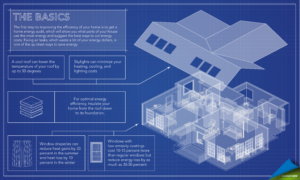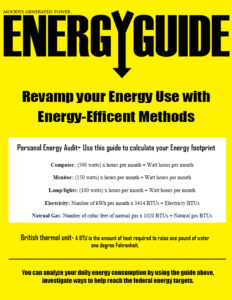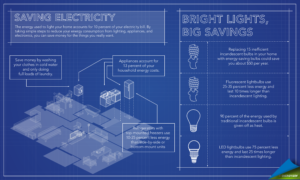
Courtesy : Energy.gov
It’s wiser to save energy than to make energy
Caulking Windows:
If you want to offset few dollars on your monthly utility bills, the right place to analyse is at your current home. First, look at your heating bills. If you heat with natural gas or fuel oil, it’s easy to find the separate monthly item even if it’s billed by your electric utility. Most homeowners can save 20 to 25 percent by caulking air leaks around windows, doors, foundations and soffits.
Insulation:
Check the attic insulation. It’s cheap to add an extra layer of batting or blown-in cellulose. It’s more expensive to swap out old single-pane or metal-frame windows for more efficient modern insulated triple-pane wood- or vinyl-frame windows. The inexpensive fix of all is to renew weather-stripping around all doors and window sashes, and put insulating covers on pet doors.
Spending $2,000 or more on insulating upgrades may cut heating costs by 50 percent and pay for itself in about three years. The Department of Energy website includes interactive worksheets to help you figure out how much more insulation you may need (depending on your climate), how much it may cost and, depending on what you’re paying for heat energy today, how long the payback period may be.
See more information on Energy efficiency
HVAC:
Heating and cooling systems can usually be improved. Be sure to change the furnace air filter quarterly. Get duct work cleaned and air leaks sealed, and make sure that ducts are insulated at least to local codes. Your duct work should be set up to heat (or cool) re-circulated air from inside the house, but the furnace should draw combustion air from outside — you don’t want to burn fuel using air you’ve already paid to heat.
If you heat with oil or electricity, consider installing a modern high-efficiency gas furnace or ground-source heat pump. A $6,000 investment in insulating and H VAC improvements might pay for itself in five or six years.
Energy Audits:
Not sure where to start? The most direct way to find cost-effective fixes, especially in an older house, is with a professional energy audit. Check with your utility company to see if they offer free or reduced-cost audits. Standard price for this service is $200 to $400. It may include a blower-door test to locate air leaks.
Appliances:

Courtesy : Energy.gov
The typical refrigerator built in 80’s costs about $250 in electricity to run for a year, at today’s average rate of 16 cents per kilowatt-hour. A modern high-efficiency refrigerator runs for about $75 a year. The average homeowner would save $175 a year ― enough to pay for the refrigerator in a few years. A modern front-loading clothes washer uses far less hot water than the old top-loaders, and that saves money.
Most hot water heaters can be made more efficient by installing tank less water heaters. Fix all leaks. Turn the thermostat down to 122°F (50°C). Be sure all water lines, and the water heater itself, are fully insulated. Use low-flow shower heads.
The Department of Energy publishes a list of high-efficiency appliances and appliance tips on its website.
Brighter lights, Big Savings!

Courtesy : Energy.gov
Most people already know that the easiest way to cut your electric bill is by replacing incandescent light bulbs. Incandescent bulbs waste about 95 percent of their energy as heat. If you run six lamps for six hours each night, (let’s say one light each in the kitchen, dining room, living room, bedroom, bathroom and hall), using 15-watt long-life compact fluorescent lamps (CFLs) would save $72 in the first year over incandescent bulbs.
Does someone in the house leave the color TV set on for hours at a time? With its cable box, it burns about 310 watts. TV sets (and computers too) can draw 5 to 10 watts continually, even when shut down, unless you pull the plug. Solution: Use a switchable power strip. A large attic fan may draw 370 watts, but that’s cheaper than an air conditioner, which draws about 1,900 watts per ton of cooling capacity.
